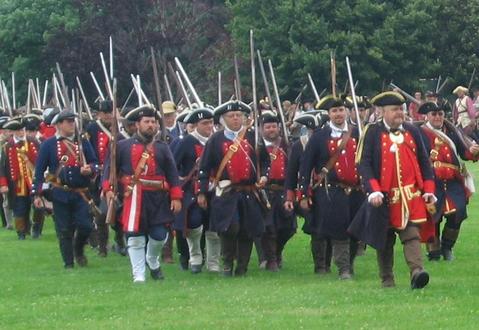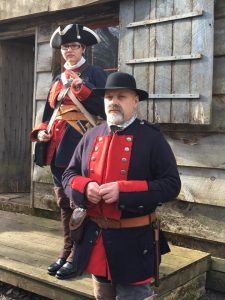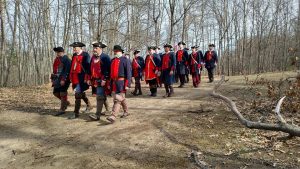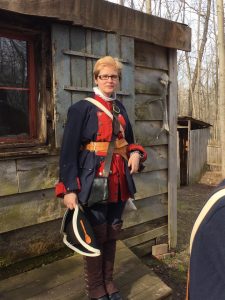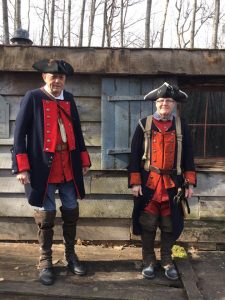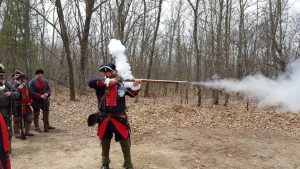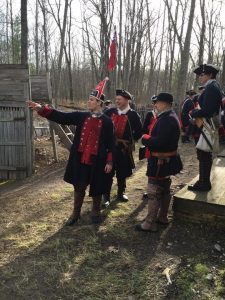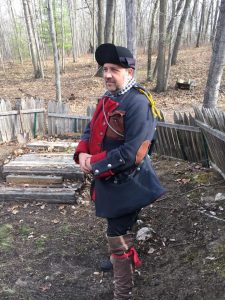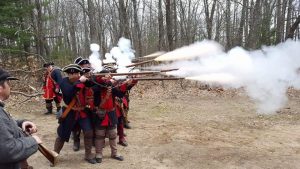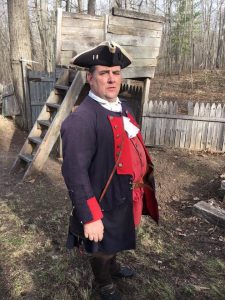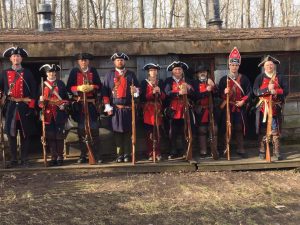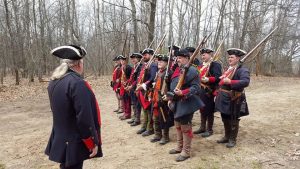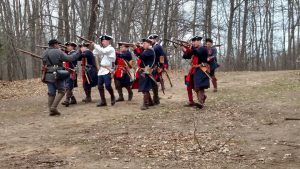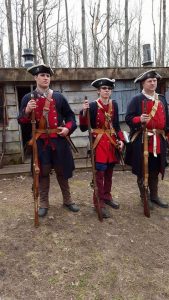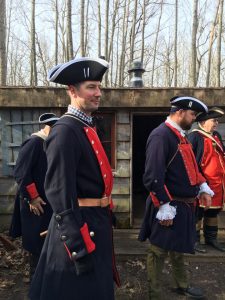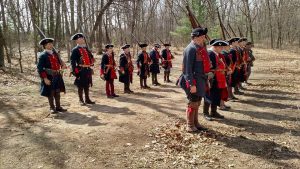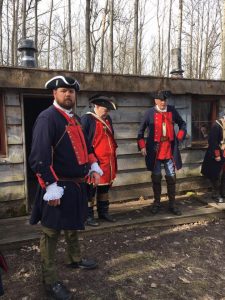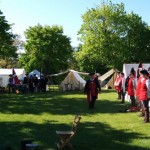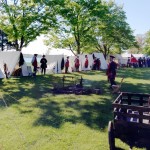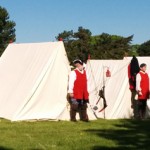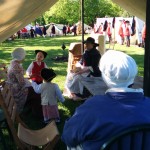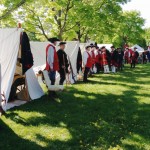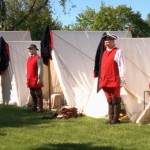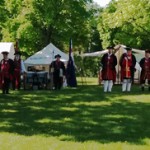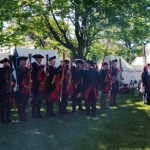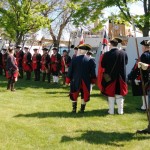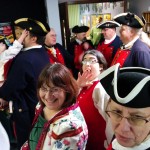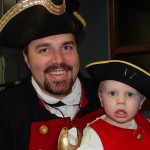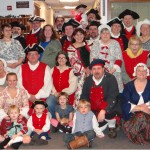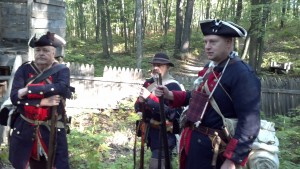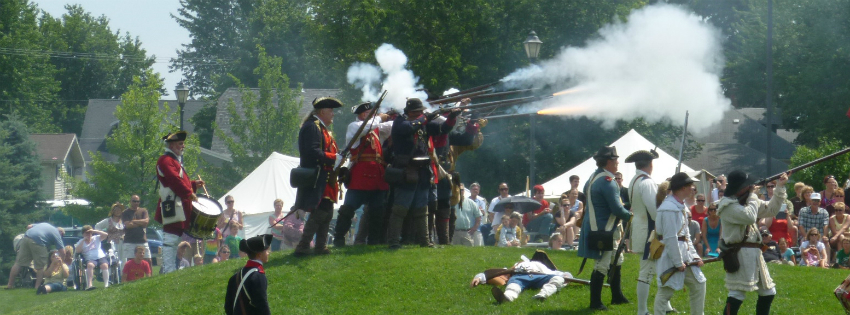Every year our battalion gathers at Fort Bagley in mid Michigan to train for the summer’s campaign against the French and their Savage allies. This year we had 15 Officers, NCOs and Centinels, including one new trooper, Mike “The Butcher” Kelly. The weather was pleasant and we spent the morning marching, working on movements, evolutions and the manual of arms. After foraging in town for lunch, the afternoon was spent spent in firing drills and a short lecture on the Regiment’s history by Major Kemmer.
Two paintings are known to exist of Massachusetts soldiers, militia and provincial from the French and Indian war period.
1756 Painting on left, held in the National Gallery of Art, Washington, D.C. and by Joseph Blackburn was an English portrait painter who worked mainly in Bermuda and colonial America. Dark navy coat with red facings, gold laced button holes and hat, and buttons and gold waistcoat. White shirt, black neck cloth. This painting is newly discovered by us.
1763 Painting on right held in The Peabody Essex Museum of Salem, MA. is an oil painting of David Mason in Company officer’s uniform. Mason was a commissary in 1755, a Lt. 1756-58, 1762 and Captain in 1763. Dark navy coat with red facings and waistcoat with gold laced waistcoat and hat. White shirt and black neck cloth.
As I interpret these the 1756 painting shows an early war and also an officer’s prerogative to deviate his trappings. He is a higher ranking officer so has more gold. You can just barely make out some of his right cuff which appears to be of the likeness to ours, but the facing was different (because of an earlier style or maybe again officer’s prerogative). The 1763 painting shows a late war lower ranking officer, so less gold and in later war we have seen an attempt at more regimented warrants in uniforms, consequently less deviations in style.
I do have documents and paintings of red coats for officers (usually high ranking) also.
My take and two cents! We will not be making changes to our recreated uniforms. This new find just adds to our authenticity package.
Major K


Holy Roman Emperor Charles the VI had no sons and spent his life securing the inheritance of his daughter, Maria Theresa Walburga Amalia Christina, commonly known as Maria Theresa. On Charle’s death in 1740, the nations of Europe repudiated their signed treaties and took up arms to dismember her realm. They realized too late that Maria Theresa was no mere slip of girl, but one of the toughest women in history and a bloody eight year war was the result.
This war ended just six short years before Washington’s expedition and the battle of Fort Necessity. It took a heavy toll in the Northern British colonies and would be as relevant to the men of Massachusetts as the first Persian Gulf war is to Americans today.
In Europe, Saxony, Prussia, Bavaria, France and Spain all made war upon Austria. Extensive and bloody battles were fought across southern Germany and in the Low Countries. This potential upset to the balance of power greatly alarmed Britain but a formal declaration of war did not come until 1744, even though King George II entered the war in his capacity as elector of Hanover in 1742 and personally won a great victory against the French at Dettingen in 1743. The appointment of Marshal de Saxe reversed all of this for the French. In 1745, the lily banners rapidly overran Belgium (one of Maria Theresa territories at that time) and French ships returned Bonnie Prince Charlie to Scotland. His rebellion forced the British Army to withdraw from Europe and Hanover, King George II’s ancestral home, quickly fell to the French.
The war reach North America in the summer of 1744. Indian’s allied to the French raided the fishing port of Canso and the capital of British Nova Scotia, Annapolis Royal and besieged Fort Ann. The fort was saved by the arrival of troops and supplies from Massachusetts. In 1745 William Pepperrell took command of a force of about 3,500 Massachusetts, 500 Connecticut and 450 New Hampshire troops to capture the fortress of Louisbourg after a six week siege. The following November, French and Indian forces raided and destroyed the village of Saratoga, New York and caused all settlements north of Albany to be abandoned. Extensive and devastating raids took place along the both the Massachusetts and New York frontiers in 1746, including attacks on Schenectady, New York and Fort Massachusetts in Western Massachusetts. The French Navy attempted to retake Louisbourg that year, but was decimated by storms and disease and never reach Cape Breton Isle. Indian Raids would continue until the war ended in 1748. Fighting in Acadia and Nova Scotia continued until the expulsion of the Acadians in the opening stages of the French and Indian War.
Conflict ended with the Treaty of Aix-la-Chapelle in 1748. The Massachusetts actions at Louisbourg represented the only bargaining chip in British hands during the negotiations. Britain traded Louisbourg back to the French for the return of Madras in India and withdrawal of French troops from the Low Countries and Hanover, restoring English positions in Europe. News of this decision was bitterly received in the Colonies. Border disputes in the Ohio country and Nova Scotia and concerns of colonial security against Indian raids went unresolved making a new colonial war inevitable.
Rifling is a series of grooves cut in a spiral pattern inside the barrel of a firearm. These grooves spin-stabilize the projectile producing straighter and more accurate flight. The importance of putting a spin on a projectile was known to archers for a long time and was implemented by offsetting the fletching feathers on their arrows. It was first applied to firearms in Germany starting in the late 15th century. The early examples were greatly improved upon by the middle of the 16th century.
A rifles projectile must have a tight fit to engage the grooves and spin. This makes a rifle much more difficult to load than a musket. Small greased patches have to be supplied to the riflemen to wrap the projectile, and much more force used to seat it properly. This generally slows the loading process to roughly half that of a comparable musket. Additionally most 18th century rifles were not designed for military service and so have no provision for mounting a bayonet and are not built robustly enough to survive hand to hand combat. This puts the rifleman at a great disadvantage in close quarters combat.
Evidence for use of rifled guns in the French and Indian war is common, but no known guns survive from the main period of the conflict. Newspapers in many places were advertising rifle parts for commercial sale as this example from South Carolina shows;
The SOUTH-CAROLINA Gazette
November 4, 1756
JOHN DODD , Gun-Maker in Meeting-Street
CHARLES-TOWN
HAS to sell a parcel of very neat rifle-barrel guns, from 3 to 4 feet in length; and continues to do all sorts of gun-work in the best manner.
Accounts of native raiders in Pennsylvania with rifles appear as early as 1730 and go all through the French and Indian war period. Robert Kirk, a private in Montgomery’s Highlanders (77th Foote), purchased a rifle during his period of Indian adoption over the winter of 1758-59.
“We hunted here for two moons or better and had great success. Some French traders coming up the Ohio, exchanged powder and shot with us for furrs and skins. I had succeeded so well in this party that I bought a riffle gun, some powder, and two new blankets, one of which I sent as a present to my adopted spouse, which was received as a great mark of my love and affection” (McCulloch & Todish, 48)
Natives lived and died by their ability to hunt and recognized the superior abilities of rifled guns.
‘Riffled Carbines’ were issued to the light infantry for Abercromby’s Ticonderoga campaign at a rate of one per ten men in the following regiments; 27th, 42nd, 44th, 46th, 55th, 60th, 80th (Gages Light Armed), and Bradstreets Batteaumen.
Gerneral order for 12 June 1758 were “Fort Edward Camp. Each Regt. to receive 10 riffled pieces from the store, and to return the like number or firelocks for them”.
July 1, 1758 ” Capt Sheperds Company of Rangers to discharge thier pieces between 3 and 5 this afternoon. The Regts may try thir riffles at the same time”.
As for the provincials Colonel Bouquet, of the 60th Royal Americans, wrote, “A large part of the provincials are armed with grooved rifles, and have molds. Lead in bars will suit them better than buttlets—likewise the Indians—but they also need fine powder FF”
Production of Jaeger style rifles took place in the German states from the beginning of the 17th century and were in military service with specialist German troops from the 1650s. Sweden began importing them in 1711 and they would have been commercially available in Europe and could have been imported into America or immigrated with Germanic and Swiss settlers.
The oldest surviving American rifle is the John Shreit rifle housed in the William duPont collection and dated to 1761. Unfortunately this rifle was rebuilt in the early 19th century and so cannot be used as an example of an F&I era gun. The first of the famous Pennsylvania long rifle makers, Andreas Albrecht, opened his shop in Christian Springs PA in 1761. These early guns probably resembled trade muskets and were intended for sale, although not exclusively, to the natives.
Although rifle choices in history were many, the modern F&I era rifleman has a much more limited selection. The only production replica rifle available today is Pedersoli’s Jaeger rifle and that is the one I’ve been carrying this season. Other historic guns are only available in kits or parts sets and require considerable gunsmithing skills to complete them. This comes with the advantage of uniqueness but at considerable cost. As always speak with your officers and NCOs before spending money on a gun that may not be appropriate
Sources
Ian McCulloch and Timothy Todish Through So Many Dangers; The memoirs and Adventures of Robert Kirk, Late of the Royal Highland Regiment. New York NY, Purple Mountain Press, 2004
Peter A. Alexander The Gunsmith of Grenville County; Building the American Longrifle. Texarkana TX, 2012
Ian McCulloch & Tim J Todish British Light Infantryman of the Seven Years War; North American 1757-1763. Wellingborough UK, Osprey Publishing 2004
(Wikipedia) https://en.wikipedia.org/wiki/Rifling
Feast of Ste. Clare was this past Memorial Day Weekend. We had a great time and it was wonderful seeing everyone after the long cold winter. Click on an image below to see the full picture.
 This past weekend was the Kalamazoo Living History Show. It was good to see so many people there. We had a great turn out, you couldn’t walk around without seeing a blue coat with red facings. Afterwards shared cake with Karen Kemmer, one of our cannon crew, for her Birthday. Happy Birthday Karen!!!
This past weekend was the Kalamazoo Living History Show. It was good to see so many people there. We had a great turn out, you couldn’t walk around without seeing a blue coat with red facings. Afterwards shared cake with Karen Kemmer, one of our cannon crew, for her Birthday. Happy Birthday Karen!!!
Earlier this month we had our annual Holiday meeting where we all got together to discuss last year, plan for the upcoming year and have some fun. Our reenacting family is growing, but we’d still love to have more friends to share our hobby with. Our group has a variety of men, women and children who are active participants. For us, reenacting is for the whole family. If you are considering joining us, come check us out at an event or contact us ahead of time and maybe you can come and join us on the field!
Robert Kegerreis has shot a short documentary about the reenactment at 2013 Colonial Kensington event. Its 16 minutes long and features the finest looking bunch of patriots in blue coats to be found.
Hey Everybody,
I’ve got some great pictures from the Battalion Fall Challenge Event, held at Fort Bagley in Houghton Lake MI on September 13th, 14th and 15th. Our annual fall challenge is a private event to build our skills, test the things we’ve learned and celebrate another excellent year of reenacting the conflicts of the 18th Century. Check out the photos to see the fun we had. This event is open to other reenacting units. Contact Major Kemmer for details.
The weekend of July 20th-21st we attended the Cass River Encampment at Frankenmuth’s River Place Shops. We had so much fun doing tacticals as both F&I and Revolutionary War participants. The weather was especially good. Be sure to follow the link below for more great photos.
Check out more photos at Trish’s Photobucket.

